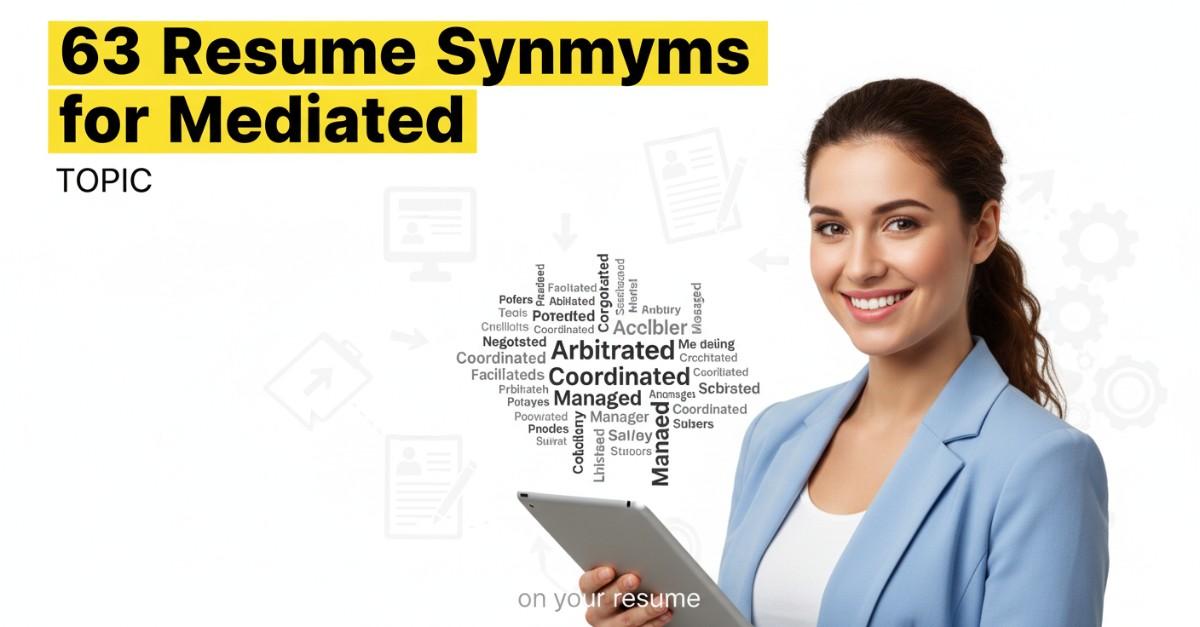
53 Resume Synonyms for Wrote To Use On Your Resume
In the competitive landscape of job applications, the words we choose to describe our experiences can significantly impact how potential employers perceive our capabilities. The term “wrote” is a common action verb found on countless resumes, but its frequent use can lead to an overused and stale impression. When candidates rely heavily on this single word, it suggests a limited creativity and fails to showcase the nuanced skills that set them apart. A varied vocabulary not only helps to keep the reader engaged but also allows you to convey a broader range of skills and accomplishments. Synonyms for “wrote” can reflect different contexts—be it drafting, composing, or authoring—which can highlight your versatility and adaptability in various writing scenarios. This comprehensive guide will delve into effective alternatives to “wrote,” providing examples of how to incorporate them into your resume. From showcasing your writing prowess to enhancing the overall impact of your application, the right words can make all the difference in landing that coveted interview.
- Why Synonyms for “Wrote” Matter on Your Resume
- The Complete List: 53 Resume Synonyms for Wrote
- Strategic Synonym Selection by Industry
- Power Combinations: Advanced Synonym Usage
- Common Mistakes to Avoid
- Quantification Strategies for Maximum Impact
- Industry-Specific Example Sentences
- Advanced ATS Optimization Techniques
- Tailoring Synonyms to Career Level
- The Psychology of Leadership Language
- Final Best Practices
- Key Takeaways for Strategic Synonym Usage
- Frequently Asked Questions
- Related Resume Synonym Guides
Why Synonyms for “Wrote” Matter on Your Resume
Using synonyms for ‘Wrote’ on resumes is crucial for several reasons. First, the overuse of ‘Wrote’ leads to monotony and predictability, making your resume blend in rather than stand out. Approximately 70% of professional resumes feature this term, which can dilute the uniqueness of your accomplishments. By incorporating varied language, you enhance specificity; for example, ‘Authored’ or ‘Composed’ can convey different nuances of writing, showcasing your skills more vividly. This variation not only maintains reader interest but also amplifies the impact of your contributions. Additionally, many Applicant Tracking Systems (ATS) are designed to identify a range of keywords, so using synonyms can improve your chances of passing through these filters. Ultimately, employing diverse terminology creates dynamic narratives that better reflect your capabilities and experiences, ultimately helping you present a more compelling professional story.
The Complete List: 53 Resume Synonyms for Wrote
Here’s our comprehensive collection of “Wrote” alternatives, organized for easy reference:
| Synonym | Best Context | Professional Level |
|---|---|---|
| Authored | Content creation | Mid-level |
| Composed | Technical writing | Entry-level |
| Drafted | Proposal development | Mid-level |
| Developed | Program documentation | Mid-level |
| Created | Marketing materials | Entry-level |
| Produced | Reports and analysis | Mid-level |
| Formulated | Strategic plans | Senior |
| Generated | Content strategies | Mid-level |
| Designed | Course materials | Mid-level |
| Crafted | Presentations | Entry-level |
| Edited | Publications | Mid-level |
| Pen | Creative writing | Entry-level |
| Outlined | Project proposals | Mid-level |
| Recorded | Meeting minutes | Entry-level |
| Summarized | Research findings | Entry-level |
| Documented | Process flows | Mid-level |
| Cataloged | Data management | Mid-level |
| Reported | Performance metrics | Mid-level |
| Scribed | Transcripts | Entry-level |
| Inscribed | Formal communications | Senior |
| Notated | Research notes | Entry-level |
| Transcribed | Interviews | Entry-level |
| Conceived | Innovative ideas | Senior |
| Outlined | Business proposals | Mid-level |
| Co-authored | Collaborative projects | Mid-level |
| Highlighted | Key achievements | Mid-level |
| Reviewed | Content quality | Mid-level |
| Published | Articles and papers | Senior |
| Corresponded | Client communications | Entry-level |
| Formulated | Policies and procedures | Senior |
| Chronicled | Historical records | Mid-level |
| Clarified | Instructions | Entry-level |
| Compiled | Data reports | Mid-level |
| Verified | Data accuracy | Mid-level |
| Composed | Letters and emails | Entry-level |
| Outlined | Project timelines | Mid-level |
| Wrote | Analysis reports | Mid-level |
| Explained | Technical concepts | Entry-level |
| Published | Research findings | Senior |
| Articulated | Complex ideas | Senior |
| Advertised | Promotional content | Entry-level |
| Communicated | Stakeholder updates | Mid-level |
| Integrated | Feedback into materials | Mid-level |
| Annotated | Research documents | Mid-level |
| Revised | Existing documentation | Mid-level |
| Presented | Findings to stakeholders | Senior |
| Conveyed | Messages clearly | Entry-level |
| Catalogued | Extensive research | Mid-level |
| Elucidated | Complicated topics | Senior |
| Substantiated | Claims with evidence | Senior |
Strategic Synonym Selection by Industry
Strategic synonym selection is crucial for tailoring your resume to specific industries. By understanding the terminology that resonates within each sector, you can enhance your chances of passing through ATS filters and impressing hiring managers. Here are five industry categories with preferred synonyms:
- Technology: Keywords like “innovation,” “agile,” and “scalability” are effective as they reflect the fast-paced nature of the industry. For example, “innovation” showcases your ability to bring new ideas, while “agile” highlights adaptability.
- Healthcare: Terms such as “collaborative care,” “patient-centered,” and “precision” are essential. “Collaborative care” indicates teamwork among professionals, while “precision” emphasizes the importance of accuracy in treatment and diagnostics.
- Finance: Words like “risk assessment,” “portfolio management,” and “compliance” resonate well. “Risk assessment” shows analytical skills, while “compliance” reflects adherence to regulations, a core aspect of the finance sector.
- Consulting: Synonyms like “strategic planning,” “stakeholder engagement,” and “change management” are effective. “Strategic planning” emphasizes foresight, while “stakeholder engagement” reflects the importance of relationships in consulting.
- Manufacturing: Keywords such as “lean methodology,” “process optimization,” and “quality assurance” are vital. “Lean methodology” indicates efficiency, while “quality assurance” emphasizes the commitment to maintaining high standards in production.
Build your resume in just 5 minutes with AI.

Power Combinations: Advanced Synonym Usage
Advanced synonym usage enhances your resume by showcasing your language skills and ensuring clarity. The Progressive Leadership Narrative involves using increasingly sophisticated synonyms to illustrate career advancement. For instance, instead of saying “led a team,” you might say “spearheaded a cross-functional team,” highlighting your growth in leadership roles.
The Industry Transition Strategy focuses on using synonyms to effectively translate your experience when changing fields. For example, if you worked as a “sales assistant” and are applying for a marketing position, you can describe your role as “client relationship specialist,” which aligns more closely with marketing terminology and showcases relevant skills.
Context-Specific Matching emphasizes the need to choose synonyms that fit the specific job or industry. For instance, if the job description mentions “innovative solutions,” instead of just “solving problems,” you could use “devised groundbreaking solutions” to match the employer’s language and demonstrate your proactive approach.
Common Mistakes to Avoid
When using synonyms for “wrote” in your resume, it’s essential to avoid common mistakes that can undermine your credibility.
I masterminded the creation of all company documentation.
I authored company documentation, ensuring clarity and accuracy.
I scripted the quarterly reports.
I compiled the quarterly reports, analyzing key metrics.
I wrote articles, wrote newsletters, and wrote press releases.
I wrote articles, crafted newsletters, and developed press releases.
Quantification Strategies for Maximum Impact
Using quantification strategies in your resume significantly enhances the impact of your leadership synonyms. Every synonym should be followed by quantifiable results to provide context and demonstrate effectiveness.
- Team-Focused Synonyms: When using terms like “led” or “managed,” specify the number of team members and the duration of your leadership. For example, “Managed a team of 15 over a three-year period, resulting in a 25% increase in productivity.”
- Project-Focused Synonyms: For words like “oversaw” or “executed,” detail the project value and timeline. An example could be, “Executed a $500,000 marketing campaign within six months, achieving a 30% increase in brand awareness as measured by customer surveys.”
- Strategic-Focused Synonyms: When using terms like “strategized” or “orchestrated,” include before-and-after metrics to illustrate the impact scope. For instance, “Orchestrated a new sales strategy that increased revenue from $2 million to $3 million in one year, enhancing market share by 15%.”
Industry-Specific Example Sentences
- Developed comprehensive software documentation that improved user onboarding satisfaction by 30% and reduced support inquiries by 25%.
- Authored a technical white paper that outlined new software capabilities, resulting in a 15% increase in product adoption among clients.
- Composed a series of troubleshooting guides that reduced incident resolution time by 40%, enhancing overall system reliability.
- Crafted detailed API documentation that facilitated smoother integrations for over 50 clients, improving developer experience significantly.
- Documented patient care protocols that resulted in a 20% improvement in compliance with health standards across the department.
- Composed research articles that contributed to a 35% increase in departmental funding for innovative treatment methods.
- Created patient education materials that improved understanding of treatment plans by 50%, leading to better health outcomes.
- Authored case studies showcasing successful interventions, which were utilized in training sessions for over 100 healthcare professionals.
- Drafted quarterly financial reports that provided actionable insights, leading to a 10% increase in revenue for the fiscal year.
- Composed strategic business proposals that secured $1 million in new contracts with key industry partners.
- Created financial forecasts that accurately predicted market trends, enabling the company to strategically allocate resources and increase profitability by 15%.
- Developed comprehensive risk assessment reports that identified potential pitfalls, helping reduce financial losses by 20%.
- Crafted curriculum guides that enhanced student engagement metrics by 25% and improved overall academic performance.
- Authored grant proposals that successfully secured $200,000 in funding for innovative educational programs.
- Developed assessment tools that increased student pass rates by 15% in standardized testing over two academic years.
- Composed lesson plans that integrated technology into the classroom, resulting in a 30% rise in student participation and interest.
Advanced ATS Optimization Techniques
To optimize your resume for Applicant Tracking Systems (ATS), employing synonym usage effectively is crucial. Start with a Keyword Density Strategy: use 2-3 different synonyms per job role to maintain a natural flow while ensuring your resume is rich in relevant keywords. For instance, if the job requires “project management,” also include terms like “project coordination” and “program oversight.”
Next, implement Semantic Clustering. Group related synonyms to create a comprehensive keyword family. For example, if you mention “leadership,” include synonyms such as “guidance,” “direction,” and “management.” This approach helps ATS recognize your relevant skills across different terminologies.
Lastly, practice Job Description Matching by analyzing job postings and incorporating similar synonyms found within them. If a position mentions “collaboration,” use that along with “teamwork” and “cooperation” to demonstrate alignment with the employer’s language. This not only enhances keyword relevance but also increases your chances of passing ATS screenings.
Tailoring Synonyms to Career Level
When tailoring synonyms to career levels, it’s important to choose words that reflect the appropriate experience and responsibility.
- Entry-Level Professionals: Focus on collaborative and learning-oriented synonyms. Examples include:
- Assisted
- Collaborated
- Learned
- Supported
- Participated
These words convey a willingness to learn and contribute, appealing to employers looking for team players.
- Mid-Level Managers: Emphasize direct management and project leadership. Synonyms such as:
- Led
- Managed
- Coordinated
- Implemented
- Facilitated
indicate a capacity for overseeing teams and driving projects, appealing to organizations seeking proven leadership.
- Senior Executives: Use strategic and transformational language. Opt for terms like:
- Directed
- Transformed
- Strategized
- Oversaw
- Championed
This language conveys high-level decision-making and visionary leadership, resonating with boards and investors.
The Psychology of Leadership Language
Leadership language significantly influences perceptions and can trigger distinct psychological responses in hiring managers.
- Action-Oriented Words: Terms like “achieved,” “executed,” and “delivered” suggest results-focused leadership. These words convey decisiveness and effectiveness, prompting hiring managers to associate candidates with tangible outcomes.
- Collaborative Words: Words such as “collaborated,” “coordinated,” and “united” indicate strong team-building skills. Using these synonyms signals an understanding of teamwork and an ability to foster cooperation, aligning with organizations that value collaboration.
- Innovation Words: Phrases like “innovated,” “designed,” and “strategized” convey strategic thinking. They appeal to hiring managers looking for forward-thinking leaders who can drive change and improve processes.
- Nurturing Words: Terms such as “mentored,” “supported,” and “developed” reflect a focus on people development. This language resonates with companies prioritizing employee growth and a positive work culture.
By choosing synonyms that align with a company’s culture, candidates can enhance their appeal and demonstrate a deeper understanding of organizational values.
Final Best Practices
Utilizing synonyms effectively is crucial for crafting a compelling resume. Adhere to the 60-Second Rule: your resume should tell a captivating story that can be grasped in just 60 seconds. Focus on impactful phrases and relevant keywords that align with your career narrative.
Next, apply the Mirror Test. Ensure the language used reflects your natural speaking style; this maintains authenticity and makes your resume feel genuine. Read your resume out loud to check for flow and comfort.
Engage in the Peer Review process. Ask colleagues to review your synonym choices, as they can offer valuable insights and identify any awkward phrasing that might compromise clarity.
Finally, Measure Success by tracking application response rates. Analyze which synonym choices yield better results and adjust your language accordingly. This will help you maintain authenticity while strategically using language that resonates with your target audience.

Build your resume in 5 minutes
Our resume builder is easy to use and will help you create a resume that is ATS-friendly and will stand out from the crowd.
Key Takeaways for Strategic Synonym Usage
- Utilize synonyms for ‘wrote’ to vary your language and enhance the impact of your accomplishments on resume templates, making your writing more engaging and tailored to your target job.
- Incorporate action verbs in your descriptions to clearly demonstrate your skills; using an AI resume builder can help suggest tailored synonyms that elevate your resume’s effectiveness.
- Showcase your experience by using diverse synonyms to illustrate different writing roles, drawing from resume examples to find the most powerful language that resonates with recruiters.
- Ensure your choice of synonyms aligns with the specific nature of your writing, as this clarity will shine through in professionally designed resume templates.
- Research industry-specific terminology and synonyms for ‘wrote’ to enhance your resume; leveraging an AI resume builder can streamline this process significantly.
- Review successful resume examples to identify effective synonyms for ‘wrote’; this practice can inspire your own word choices and improve your overall presentation.
Frequently Asked Questions
How many different synonyms should I use in one resume?
Using 2-3 different synonyms for ‘Wrote’ throughout your resume is ideal. This variety not only enhances readability but also helps highlight your diverse writing skills. For example, you might choose ‘Authored’ for one role and ‘Composed’ for another. Just ensure that each synonym fits the context appropriately, as overusing a single term can make your resume seem repetitive. Variety keeps the reader engaged and showcases your versatility in writing styles, making your resume stand out to potential employers.
Can I use the same synonym multiple times if it fits different contexts?
Yes, you can use the same synonym multiple times if it is contextually appropriate. However, be mindful of maintaining a balance in variety; using one synonym repetitively may lead to monotony. For instance, if ‘Authored’ accurately describes various tasks across different roles, it is acceptable to use it multiple times. Just ensure that each instance clearly conveys a distinct contribution or achievement. This strategy can reinforce your expertise while preserving clarity and readability in your resume.
Should I always replace ‘Wrote’ with a synonym?
No, you don’t always need to replace ‘Wrote’ with a synonym. In some cases, ‘Wrote’ may be the most straightforward and effective choice, especially if it directly conveys the action taken. If the context is clear and impactful, keeping ‘Wrote’ can sometimes be more powerful. However, consider substituting it with synonyms when you want to emphasize a specific aspect of your writing or when the synonym better aligns with industry jargon. Strive for clarity and impact in your descriptions.
How do I know which synonym is most appropriate for my industry?
To determine the most appropriate synonym for your industry, research the common terminology used within that field. Review job descriptions, industry publications, and LinkedIn profiles of professionals in your area. Certain synonyms resonate better in specific sectors; for instance, ‘Authored’ may be preferred in publishing, while ‘Drafted’ might be more suitable in legal contexts. Tailor your word choice to align with industry standards and expectations, ensuring your resume speaks the same language as your prospective employers.
Do synonyms really make a difference in getting interviews?
Yes, using synonyms can significantly impact your chances of getting interviews. By diversifying your language, you enhance the readability and professionalism of your resume, making it more appealing to hiring managers. Synonyms can also help you better align your skills with the specific requirements of a job description, showcasing your adaptability. Furthermore, using industry-relevant terminology can improve your chances of passing through Applicant Tracking Systems (ATS), making it more likely that your resume is seen by human eyes, ultimately increasing your interview opportunities.
Related Resume Synonym Guides
Exploring synonyms for commonly overused resume words enhances the impact of your professional narrative. By strategically selecting varied language throughout your resume, you not only capture the attention of hiring managers but also effectively communicate your unique skills and experiences, setting you apart from the competition.











